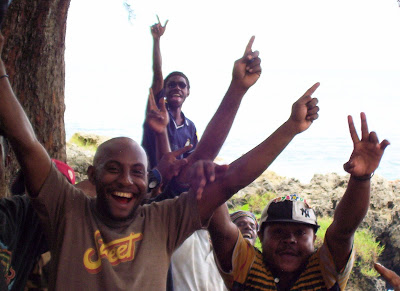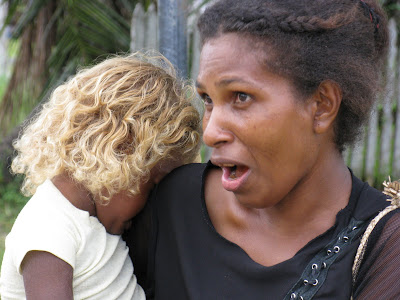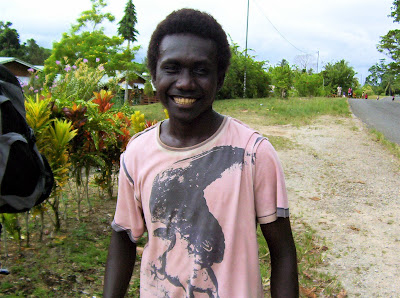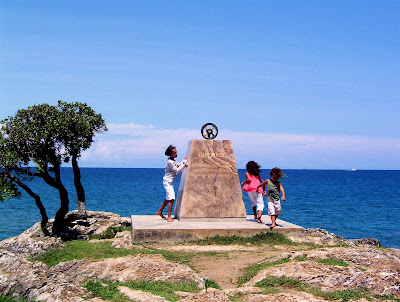Two days and one night in Espiritu Santo. What I mean is JUST two days and one night… ones I shall certainly not forget in a hurry.
In Santo, the shipping line takes the passengers on a tour to the ‘selected highlights’ of the island – the pretty coral-sands of Champagne beach, the impressive Blue Holes, a copra processing barn, a tidy native village. A delightful tour, but I did it last year – and I was keen to stretch my legs – so the bus rolled out of Santo wharf without me. I was already a good kilometre down the road, setting out on one of my Walks.
Down through the little town of Lugainville, across the river which provided me with a couple of my favourite photos last year, and out into the green, green countryside with its masses of exotic leaves, its extraordinarily clean and picture-book cows, its smiling, hello-ing faces and its endless bevy of tiny Korean taxis … No one walks far in Santo, but the toing-and-froing taxidrivers soon got the message that this crazy fella was walking on purpose, and the offers of a ride changed into cheers, waves and hel-los…

Santo hasn’t gone undiscovered. Here and there are nestled amid the greenery fine, new, undoubtedly ‘foreign’ houses, occasionally there is a fairly discreet ‘resort’ or a glistening yacht moored alongside the cheery little pirogues. But here the mix works. Where new buildings have gone up since last year, they are sensible, low constructions and have replaced the most dilapidated of the old. Somehow, it all just seems right. And, it goes without saying, it is very lovely.
After an hour or so of walking, the tarmac underfoot gave way to a dirt road, a perilous affair, deeply potholed and runnelled by tropical rainstorms and baked solid by tropical heat. But I marched on, bouncing from pothole to pothole and paddock to paddock, under a ferocious white sun, taking in the countryside with a real enjoyment.
It was 20 kilometres and nearly four hours before I ground to a halt back at Lugainville, desperately in need of a very cold beer. I checked out the town’s hotel, I checked out a couple of beachside type resto-cafés, but I knew where I was going. I’d spotted ‘Le Némo’ on the way out, a little and unpretentious ‘French restaurant’ hidden behind a mass of trellis…
This was a day when everything was going to be perfect, and Le Némo did its part. Four Tusker beers and a plate of sizzling garlic crevettes (served by Diana, who must be quite the prettiest waitress in the entire Pacific) later, I booked the terrace table for the evening for the ship’s Eaters-Out, and headed back to the wharf.

But I didn’t quite get there. An English ‘hel-lo!’ and there was Christina (from Knaresborough), Gazellebank cadet officer, taking advantage of some time off duty for a dip in the Pacific. So we sat on the coral sand and nibbled coconut and chatted until the sea became irresistible and I (who haven’t been in the sea in years) plunged cautiously into the warm shallows .. delicious! Tina was more adventurous, and seemed at one moment to have the whole of the Pacific to herself …

The evening lived up to all the promise of the day. Gareth and Charlotte, John, Trevor and I took a leisurely sample of the delicacies of Le Némo – fresh lobster salad, roast pigeon, the local poulet fish and, quite simply, the best fish carpaccio – served with lime and capers – I have ever tasted. No-one was game to try the civet of flying fox. Alas, the rosé de Provence was ‘off,’ but a very fair Australian sauvignon blanc did sterling service instead …
Day two was going to have a lot to live up to.
But it did it.
As I’d steamed through Lugainville at the start of my Walk, a big very black man in a big very red car stopped and waved at me. I was already into the standard explanation (‘walking for pleasure, yes’) when it dawned on me, this was Kenneth who had driven us on our tour last year. Did I want to go somewhere tomorrow? Yes, I did. I wanted to go to a genuine kastom village, the kind that your average tourist doesn’t reach. And I was pretty sure the Eaters-Out would be starters as well.
And so, the next morning, the famous five plus Tiny (from Utrecht) boarded the minibus piloted by Sandie (Kenneth had gone AWOL, but this was his brother!) and headed up via joltingly hole-y dirt roads to the back country and the village of Fanafo.
Fanafo is an historic place in Santo, for this little village, where, give or take the odd plastic bucket and pair of speedos, life is lived pretty much in ‘traditional’ fashion, was the birthplace of Jimmie Stevens, the most celebrated political personality of the years during which the New Hebrides became Vanuatu.
We weren’t there for history and politics, though. Just as visitors.
You feel kind of awkward, looking at people and their homes as if they were something of a curiosity, but any kind of embarrassment vanished utterly when we were faced with the village children. What a wonderful little band! Little? I don’t know where so many babies could fit in such a small place. I didn’t see one male of child-bearing age, but they are obviously around and they are obviously decidedly active.
Every one of us fell in love with the children of Fanafo, and every one of us came away with a cameraful of infantine photos… here are some of my favourites…



When lunchtime hove to, Sandie suggested we go to where his daughter worked. Since he’d done us proud to date, that seemed like a good idea. But my heart sank when I saw the sign, bearing the dreaded word ‘Resort’. If I don’t do swimming, I definitely don’t do ‘Resorts’.
Another of my ‘don’ts’ crushed.
Oyster Island Resort is less a Resort than what the Victorians would have called ‘a Spot’. And a glorious one. I don’t know if I’d love it so much if its six bungalows and restaurant were teeming with visitors, but on this occasion we had it virtually to ourselves for a nice lunch (I had luscious calamari, but rued it when I saw John’s superb Santo steak!), and a leisurely swim in clear water, on white coral sand, thronged with little fishes…
The height of sybaritic luxury .. cold beer served to us in the warm sea .. I couldn’t resist it: I took my camera and swam out to photograph our merry band and their bathing bottles. I am rather an inept swimmer and some of the results were decidedly curious, but I managed to get Trevor and Charlotte up the right way, without sinking or drowning my camera…

John and I both checked out prices and plane schedules .. ‘for our honeymoon’ explained John (who somehow gets away with this sort of thing) to our shy young black boatman, who seemed rather delighted and not at all put out at the thought that two 60 year-old men were ‘getting married this evening’, and only slightly confused when John offered to let him take his place in the ceremony! A delightfully silly, fun ending to an utterly marvellous day…
For, yes, after we had bumped our way back to the wharf, vague thoughts of a second visit to Le Nemo faded quickly away … by 8.30pm the bar was empty, and not one of us felt the ship depart, come midnight, from the lovely, lovely land of Espiritu Santo.
















































